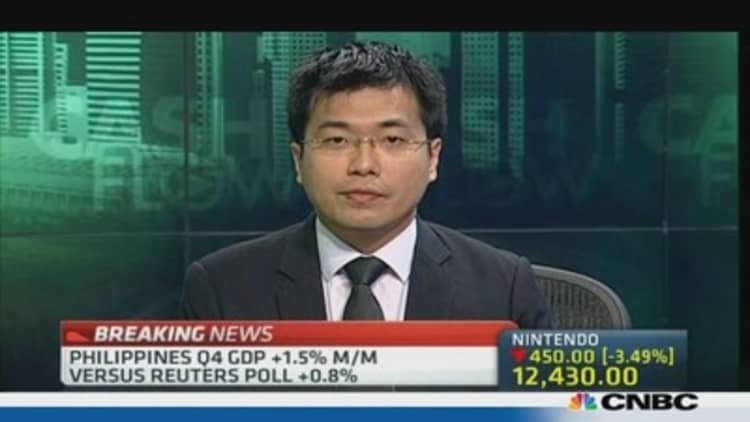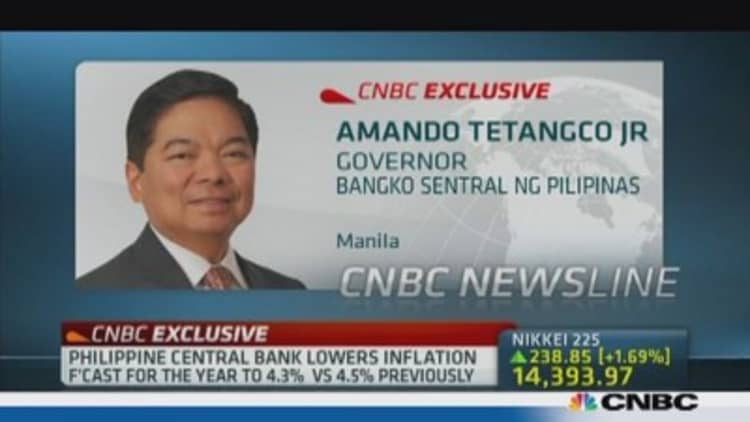The Philippine economy appears to be sitting pretty, remaining on track for solid growth, but some concerns are emerging that a bust could be on the cards.
So far, the archipelago has certainly racked up a laudable performance, with the economy expanding 7.2 percent in 2013, among the world's best performers despite a devastating typhoon, which struck the country in November.
(Read more: Investors will wake up to Philippines 'pretty soon': central bank)
At the same time, inflation has remained relatively manageable at 4.2 percent on-year in January, with the central bank recently reducing its 2014 forecast to 4.3 percent from 4.5 percent.
"There has been plenty of arguing that huge structural improvements explain this sweet spot, not least the Philippines central bank," Michael Wan, an analyst at Credit Suisse said in a note Wednesday. "We do not subscribe fully to this view."
Wan doesn't believe the structural improvements have been enough to improve the growth potential as much some analysts and the central bank expect.
(Read more: Five reasons to be positive on the Philippines)

"We suspect that strong GDP (gross domestic product) growth in recent periods has a lot to do with the central bank's extremely accommodative monetary policy," he said.
"The risk is that the central bank and government keep policy settings too loose for too long, resulting in an economy hitting capacity constraints and overheating," he said. "In other words, the policy makers repeat the mistakes of those in Indonesia and many other countries that have enjoyed what turned out to be a temporary period of high growth and low inflation."
The 7-8.5 percent growth rates expected by the Philippine government over the next three years exceed the increase in productive potential, he said.
(Read more: How some emerging markets get taper insulation)
While fixed investment has been trending higher since 2009, the rate remains quite low, especially compared with other countries in the region, suggesting capex spending hasn't boosted trend GDP growth to at least 6-7 percent, Wan said.
"As an example of the cumulative lack of capex in the Philippines, the Department of Energy estimates that a power deficit could occur in 2015 if current power generation capacity does not increase," he said,
Wan doesn't expect an imminent meltdown, but he is concerned on a one to two-year view about how the central bank's easy policy is affecting capacity utilization and property prices.

To be sure, not everyone expects a bust will be on the cards, with some sticking with a bullish outlook.
"We remain optimistic about the economy," Macquarie said in a note last week. "Capacity and liquidity remain ample, and growth prospects bright."
It added that the Philippines' stock market is its only overweight call in Southeast Asia, penciling in the potential for a 20 percent rise this year.
"The investment cycle, the primary driver of stronger Philippines growth in 2013, should continue over the next two years, notwithstanding recent natural disasters, and the impact of higher electricity prices on inflation," it added, although it noted the government will need to work on creating a more conducive business environment.
(Read more: Are EM companies the real debt worry?)
Citigroup also expects strong growth ahead, citing the government's medium-term focus on regional development, including spending on social programs and infrastructure.
"Rising spending on infrastructure, especially to widen access to electricity and water, will have numerous and self-reinforcing economic benefits, including creating new and competitive industrial clusters," the bank said in a note. "Continuing cash transfers and social investment will alleviate poverty, raise education standards and help create sustainable consumer demand."
—By CNBC.Com's Leslie Shaffer; Follow her on Twitter @LeslieShaffer1

